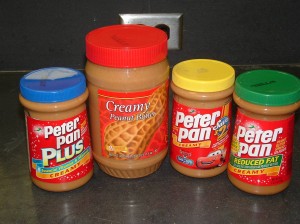Peanut butter has been associated with several large foodborne salmonellosis outbreaks. This research investigates the potential of high hydrostatic pressure processing (HPP) for inactivation of Salmonella in peanut butter of modified composition, both by modifying its water activity as well by the addition of various amounts of nisin.
 A cocktail of six Salmonella strains associated with peanut butter and nut-related outbreaks was used for all experiments. Different volumes of sterile distilled water were added to peanut butter to increase water activity, and different volumes of peanut oil were added to decrease water activity. Inactivation in 12% fat, light roast, partially defatted peanut flour, and peanut oil was also quantified. Nisaplin was incorporated into peanut butter at four concentrations corresponding to 2.5, 5.0, 12.5, and 25.0 ppm of pure nisin. All samples were subjected to 600 MPa for 18 min. A steady and statistically significant increase in log reduction was seen as added moisture was increased from 50 to 90%. The color of all peanut butter samples containing added moisture contents darkened after high pressure processing. The addition of peanut oil to further lower the water activity of peanut butter further reduced the effectiveness of HPP.
A cocktail of six Salmonella strains associated with peanut butter and nut-related outbreaks was used for all experiments. Different volumes of sterile distilled water were added to peanut butter to increase water activity, and different volumes of peanut oil were added to decrease water activity. Inactivation in 12% fat, light roast, partially defatted peanut flour, and peanut oil was also quantified. Nisaplin was incorporated into peanut butter at four concentrations corresponding to 2.5, 5.0, 12.5, and 25.0 ppm of pure nisin. All samples were subjected to 600 MPa for 18 min. A steady and statistically significant increase in log reduction was seen as added moisture was increased from 50 to 90%. The color of all peanut butter samples containing added moisture contents darkened after high pressure processing. The addition of peanut oil to further lower the water activity of peanut butter further reduced the effectiveness of HPP.
Just over a 1-log reduction was obtained in peanut flour, while inactivation to below detection limits (2 log CFU/g) was observed in peanut oil. Nisin alone without HPP had no effect. Recovery of Salmonella after a combined nisin and HPP treatment did show increased log reduction with longer storage times. The maximum log reduction of Salmonella achieved was 1.7 log CFU/g, which was comparable to that achieved by noncycling pressure treatment alone.
High pressure processing alone or with other formulation modification, including added nisin, is not a suitable technology to manage the microbiological safety of Salmonella-contaminated peanut butter.
Journal of Food Protection®, Number 10, October 2014, pp. 1656-1833, pp. 1664-1668(5)
D’Souza, Tanya; Karwe, Mukund; Schaffner, Donald W.
http://www.ingentaconnect.com/content/iafp/jfp/2014/00000077/00000010/art00002

